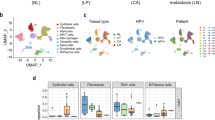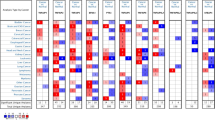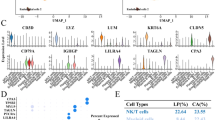Abstract
Head and neck squamous cell carcinoma (HNSCC) is common worldwide and is associated with a poor rate of survival. Identification of new markers and therapeutic targets, and understanding the complex transformation process, will require a comprehensive description of genome expression, that can only be achieved by combining different methodologies. We report here the HNSCC transcriptome that was determined by exhaustive differential display (DD) analysis coupled with validation by different methods on the same patient samples. The resulting 820 nonredundant sequences were analysed by high throughput bioinformatics analysis. Human proteins were identified for 73% (596) of the DD sequences. A large proportion (>50%) of the remaining unassigned sequences match ESTs (expressed sequence tags) from human tumours. For the functionally annotated proteins, there is significant enrichment for relevant biological processes, including cell motility, protein biosynthesis, stress and immune responses, cell death, cell cycle, cell proliferation and/or maintenance and transport. Three of the novel proteins (TMEM16A, PHLDB2 and ARHGAP21) were analysed further to show that they have the potential to be developed as therapeutic targets.
This is a preview of subscription content, access via your institution
Access options
Subscribe to this journal
Receive 50 print issues and online access
$259.00 per year
only $5.18 per issue
Buy this article
- Purchase on Springer Link
- Instant access to full article PDF
Prices may be subject to local taxes which are calculated during checkout



Similar content being viewed by others
Accession codes
Accessions
GenBank/EMBL/DDBJ
References
Altschul SF, Madden TL, Schaffer AA, Zhang J, Zhang Z, Miller W et al. (1997). Nucleic Acids Res 25: 3389–3402.
Basseres DS, Tizzei EV, Duarte AA, Costa FF, Saad ST . (2002). Biochem Biophys Res Commun 294: 579–585.
Bolstad BM, Irizarry RA, Astrand M, Speed TP . (2003). Bioinformatics 19: 185–193.
Broude NE . (2002). Expert Rev Mol Diagn 2: 209–216.
Chalmel F, Lardenois A, Thompson JD, Muller J, Sahel JA, Leveillard T et al. (2005). Bioinformatics 21: 2095–2096.
Cirelli C, Tononi G . (2000). Brain Res 885: 303–321.
Cromer A, Carles A, Millon R, Ganguli G, Chalmel F, Lemaire F et al. (2004). Oncogene 23: 2484–2498.
Dancey JE . (2004). Ann Oncol 15(Suppl 4): iv233–iv239.
Ding C, Cantor CR . (2004). J Biochem Mol Biol 37: 1–10.
Dowler S, Montalvo L, Cantrell D, Morrice N, Alessi DR . (2000). Biochem J 349: 605–610.
Draghici S, Kulaeva O, Hoff B, Petrov A, Shams S, Tainsky MA . (2003). Bioinformatics 19: 1348–1359.
Hasina R, Lingen MW . (2004). Semin Oncol 31: 718–725.
Heilig M, Sommer W . (2004). Neurotox Res 6: 363–372.
Huang X, Gollin SM, Raja S, Godfrey TE . (2002). Proc Natl Acad Sci USA 99: 11369–11374.
Huang ZX, Yao KT . (2004). Di Yi Jun Yi Da Xue Xue Bao 24: 798–801.
IHGSC (2004). Nature 431: 931–945.
Katoh M . (2003). Int J Oncol 22: 1375–1381.
Katoh M . (2004). Int J Oncol 25: 1201–1206.
Katsanis N, Worley KC, Gonzalez G, Ansley SJ, Lupski JR . (2002). Proc Natl Acad Sci USA 99: 14326–14331.
Lemaire F, Millon R, Young J, Cromer A, Wasylyk C, Schultz I et al. (2003). Br J Cancer 89: 1940–1949.
Liang P . (1998). Methods 16: 361–364.
Liang P . (2002). Biotechniques 33: 338–344, 346.
Liang P, Pardee AB . (1992). Science 257: 967–971.
Liang P, Pardee AB . (2003). Nat Rev Cancer 3: 869–876.
Lincoln DT, Ali Emadi EM, Tonissen KF, Clarke FM . (2003). Anticancer Res 23: 2425–2433.
Liotta L, Petricoin E . (2000). Nat Rev Genet 1: 48–56.
Martin KJ, Graner E, Li Y, Price LM, Kritzman BM, Fournier MV et al. (2001). Proc Natl Acad Sci USA 98: 2646–2651.
Muller D, Millon R, Velten M, Bronner G, Jung G, Engelmann A et al. (1997). Eur J Cancer 33: 2203–2210.
Oetting WS . (2000). Pigment Cell Res 13: 21–27.
Outinen PA, Sood SK, Liaw PC, Sarge KD, Maeda N, Hirsh J et al. (1998). Biochem J 332(Part 1): 213–221.
Paranavitane V, Coadwell WJ, Eguinoa A, Hawkins PT, Stephens L . (2003). J Biol Chem 278: 1328–1335.
Pascal T, Debacq-Chainiaux F, Chretien A, Bastin C, Dabee AF, Bertholet V et al. (2005). FEBS Lett 579: 3651–3659.
Smit AF . (1999). Curr Opin Genet Dev 9: 657–663.
Stein J, Liang P . (2002). Cell Mol Life Sci 59: 1235–1240.
Strausberg RL, Feingold EA, Grouse LH, Derge JG, Klausner RD, Collins FS et al. (2002). Proc Natl Acad Sci USA 99: 16899–16903.
Trenkle T, Welsh J, McClelland M . (1999). Biotechniques 27: 554–560, 562, 564.
Tusher VG, Tibshirani R, Chu G . (2001). Proc Natl Acad Sci USA 98: 5116–5121.
Wells JM . (1999). Alzheimer Dis Assoc Disord 13(Suppl 1): S78–S81.
West RB, Corless CL, Chen X, Rubin BP, Subramanian S, Montgomery K et al. (2004). Am J Pathol 165: 107–113.
Whitesell L, Bagatell R, Falsey R . (2003). Curr Cancer Drug Targets 3: 349–358.
Acknowledgements
We thank Raymond Ripp and Frédéric Chalmel for bioinformatics, Christine Macabre for technical assistance, the Wasylyk laboratory members for support and encouragement, and the IGBMC core facilities. We thank for financial support the Ligue Nationale Française contre le Cancer (Equipe labellisée), the Ligues Départementales de Lutte contre le Cancer (Haut- and Bas-Rhin), the Association pour la Recherche sur le Cancer, BioAvenir (Aventis, Rhone-Poulenc), MNRT Reseau Genhomme, the Centre National de la Recherche Scientifique, the Institut National de la Santé et de la Recherche Médicale, and the Hôpital Universitaire de Strasbourg.
Author information
Authors and Affiliations
Corresponding author
Additional information
Supplementary information accompanies the paper on Oncogene website (http://www.nature.com/onc).
Supplementary information
Rights and permissions
About this article
Cite this article
Carles, A., Millon, R., Cromer, A. et al. Head and neck squamous cell carcinoma transcriptome analysis by comprehensive validated differential display. Oncogene 25, 1821–1831 (2006). https://doi.org/10.1038/sj.onc.1209203
Received:
Revised:
Accepted:
Published:
Issue Date:
DOI: https://doi.org/10.1038/sj.onc.1209203
Keywords
This article is cited by
-
Pathophysiological role of ion channels and transporters in HER2-positive breast cancer
Cancer Gene Therapy (2022)
-
ANO1 regulates the maintenance of stemness in glioblastoma stem cells by stabilizing EGFRvIII
Oncogene (2021)
-
Upregulation of TTYH3 promotes epithelial-to-mesenchymal transition through Wnt/β-catenin signaling and inhibits apoptosis in cholangiocarcinoma
Cellular Oncology (2021)
-
Cell-specific mechanisms of TMEM16A Ca2+-activated chloride channel in cancer
Molecular Cancer (2017)
-
Epigenetic re-expression of HIF-2α suppresses soft tissue sarcoma growth
Nature Communications (2016)



